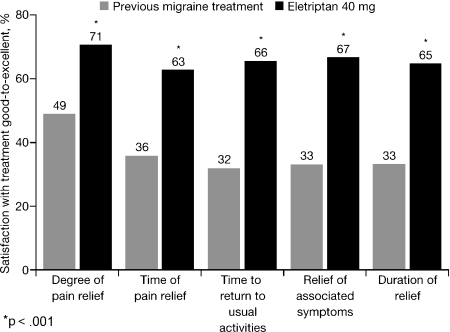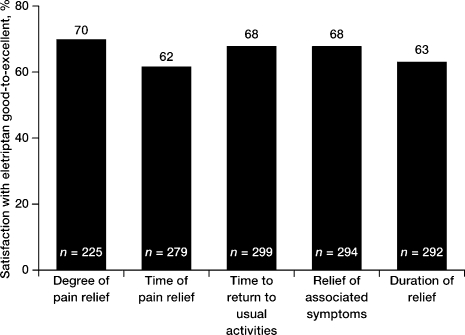
| Size | Price | Stock | Qty |
|---|---|---|---|
| 25mg |
|
||
| 50mg |
|
||
| 100mg |
|
||
| 250mg |
|
||
| 500mg |
|
||
| 1g | |||
| Other Sizes |
Purity: ≥98%
Eletriptan (formerly UK 116044; UK-116,044; UK-116,044-04; trade name Relpax), a triptan class of medication used for treatment of migraine headaches, is a potent and selective 5-HT1B and 5-HT1D receptor agonist with Ki of 0.92 nM and 3.14 nM, respectively. Eletriptan is a drug used to induce abortions.
| Targets |
5-HT1B ( Ki = 0.92 nM ); 5-HT1D ( Ki = 3.14 nM )
|
||
|---|---|---|---|
| ln Vitro |
|
||
| ln Vivo |
|
||
| Animal Protocol |
|
||
| Toxicity/Toxicokinetics |
Effects During Pregnancy and Lactation
◉ Summary of Use during Lactation Limited information indicates that a maternal dose of eletriptan up to 80 mg daily produces low levels in milk and would not be expected to cause any adverse effects in breastfed infants. Painful, burning nipples and breast pain have been reported after doses of sumatriptan and other triptans. This has occasionally been accompanied by a decrease in milk production. ◉ Effects in Breastfed Infants Relevant published information was not found as of the revision date. ◉ Effects on Lactation and Breastmilk A review of four European adverse reaction databases found 26 reported cases of, painful, burning nipples, painful breasts, breast engorgement and/or painful milk ejection in women who took a triptan while nursing. Pain was sometimes intense and occasionally led to decreased milk production. Pain generally subsided with time as the drug was eliminated. The authors proposed that triptans may cause vasoconstriction of the arteries in the breast, nipples, and the arteries surrounding the alveoli and milk ducts, causing a painful sensation and a painful milk ejection reflex. |
||
| References | |||
| Additional Infomation |
Eletriptan hydrobromide is a hydrobromide. It has a role as a serotonergic agonist, a vasoconstrictor agent and a non-steroidal anti-inflammatory drug. It contains an eletriptan(1+).
Eletriptan Hydrobromide is a triptan with specific affinity for the 5-hydroxytriptamine1B/1D receptor. Eletriptan hydrobromide binds to and acts at serotonin 5-HT1B receptors located on intracranial blood vessels which leads to vasoconstriction. This drug may also exerts its effects by binding to and activating 5-HT 1D receptors on sensory nerve endings in the trigeminal system, which results in the inhibition of pro-inflammatory neuropeptide release. Eletriptan hydrobromide is used to relieve pain or symptoms associated with migraine headaches. See also: Eletriptan (has active moiety). |
| Molecular Formula |
C22H27BRN2O2S
|
|
|---|---|---|
| Molecular Weight |
463.43
|
|
| Exact Mass |
462.1
|
|
| Elemental Analysis |
C, 57.02; H, 5.87; Br, 17.24; N, 6.04; O, 6.90; S, 6.92
|
|
| CAS # |
177834-92-3
|
|
| Related CAS # |
Eletriptan; 143322-58-1; Eletriptan-d3; 1287040-94-1
|
|
| PubChem CID |
656631
|
|
| Appearance |
Off-white to light yellow solid powder
|
|
| Boiling Point |
633.9ºC at 760 mmHg
|
|
| Melting Point |
169-171ºC
|
|
| Flash Point |
337.2ºC
|
|
| Vapour Pressure |
1.58E-16mmHg at 25°C
|
|
| LogP |
4.839
|
|
| Hydrogen Bond Donor Count |
2
|
|
| Hydrogen Bond Acceptor Count |
3
|
|
| Rotatable Bond Count |
6
|
|
| Heavy Atom Count |
28
|
|
| Complexity |
582
|
|
| Defined Atom Stereocenter Count |
1
|
|
| SMILES |
O=S(CCC1=CC2=C(NC=C2C[C@@H]3N(CCC3)C)C=C1)(C4=CC=CC=C4)=O.Br
|
|
| InChi Key |
UTINOWOSWSPFLJ-FSRHSHDFSA-N
|
|
| InChi Code |
InChI=1S/C22H26N2O2S.BrH/c1-24-12-5-6-19(24)15-18-16-23-22-10-9-17(14-21(18)22)11-13-27(25,26)20-7-3-2-4-8-20;/h2-4,7-10,14,16,19,23H,5-6,11-13,15H2,1H3;1H/t19-;/m1./s1
|
|
| Chemical Name |
5-[2-(benzenesulfonyl)ethyl]-3-[[(2R)-1-methylpyrrolidin-2-yl]methyl]-1H-indole;hydrobromide
|
|
| Synonyms |
|
|
| HS Tariff Code |
2934.99.9001
|
|
| Storage |
Powder -20°C 3 years 4°C 2 years In solvent -80°C 6 months -20°C 1 month Note: Please store this product in a sealed and protected environment, avoid exposure to moisture. |
|
| Shipping Condition |
Room temperature (This product is stable at ambient temperature for a few days during ordinary shipping and time spent in Customs)
|
| Solubility (In Vitro) |
|
|||
|---|---|---|---|---|
| Solubility (In Vivo) |
Solubility in Formulation 1: ≥ 2.75 mg/mL (5.93 mM) (saturation unknown) in 10% DMSO + 40% PEG300 + 5% Tween80 + 45% Saline (add these co-solvents sequentially from left to right, and one by one), clear solution.
For example, if 1 mL of working solution is to be prepared, you can add 100 μL of 27.5 mg/mL clear DMSO stock solution to 400 μL PEG300 and mix evenly; then add 50 μL Tween-80 to the above solution and mix evenly; then add 450 μL normal saline to adjust the volume to 1 mL. Preparation of saline: Dissolve 0.9 g of sodium chloride in 100 mL ddH₂ O to obtain a clear solution. Solubility in Formulation 2: ≥ 2.75 mg/mL (5.93 mM) (saturation unknown) in 10% DMSO + 90% (20% SBE-β-CD in Saline) (add these co-solvents sequentially from left to right, and one by one), clear solution. For example, if 1 mL of working solution is to be prepared, you can add 100 μL of 27.5 mg/mL clear DMSO stock solution to 900 μL of 20% SBE-β-CD physiological saline solution and mix evenly. Preparation of 20% SBE-β-CD in Saline (4°C,1 week): Dissolve 2 g SBE-β-CD in 10 mL saline to obtain a clear solution. View More
Solubility in Formulation 3: ≥ 2.75 mg/mL (5.93 mM) (saturation unknown) in 10% DMSO + 90% Corn Oil (add these co-solvents sequentially from left to right, and one by one), clear solution. |
| Preparing Stock Solutions | 1 mg | 5 mg | 10 mg | |
| 1 mM | 2.1578 mL | 10.7891 mL | 21.5782 mL | |
| 5 mM | 0.4316 mL | 2.1578 mL | 4.3156 mL | |
| 10 mM | 0.2158 mL | 1.0789 mL | 2.1578 mL |
*Note: Please select an appropriate solvent for the preparation of stock solution based on your experiment needs. For most products, DMSO can be used for preparing stock solutions (e.g. 5 mM, 10 mM, or 20 mM concentration); some products with high aqueous solubility may be dissolved in water directly. Solubility information is available at the above Solubility Data section. Once the stock solution is prepared, aliquot it to routine usage volumes and store at -20°C or -80°C. Avoid repeated freeze and thaw cycles.
Calculation results
Working concentration: mg/mL;
Method for preparing DMSO stock solution: mg drug pre-dissolved in μL DMSO (stock solution concentration mg/mL). Please contact us first if the concentration exceeds the DMSO solubility of the batch of drug.
Method for preparing in vivo formulation::Take μL DMSO stock solution, next add μL PEG300, mix and clarify, next addμL Tween 80, mix and clarify, next add μL ddH2O,mix and clarify.
(1) Please be sure that the solution is clear before the addition of next solvent. Dissolution methods like vortex, ultrasound or warming and heat may be used to aid dissolving.
(2) Be sure to add the solvent(s) in order.
| NCT Number | Recruitment | interventions | Conditions | Sponsor/Collaborators | Start Date | Phases |
| NCT00385008 | Completed | Drug: RELPAX(eletriptan) 40mg Tablet Drug: Combination Product (sumatriptan succinate / naproxen sodium) |
Migraine Disorders | GlaxoSmithKline | September 13, 2006 | Phase 3 |
| NCT01859481 | Completed | Drug: Placebo Drug: Eletriptan HBr 40 mg |
Migraine Without Aura Migraine With Aura |
Pfizer's Upjohn has merged with Mylan to form Viatris Inc. |
March 2000 | Phase 3 |
| NCT00259649 | Completed | Drug: eletriptan | Migraine | University of Pittsburgh | August 2004 | Phase 4 |
| NCT01139515 | Completed | Drug: Eletriptan commercial tablet |
Healthy | Pfizer's Upjohn has merged with Mylan to form Viatris Inc. |
July 2010 | Phase 1 |
| NCT00871806 | Completed | Drug: ODT #1 without water Drug: ODT #2 without water |
Healthy Volunteers | Pfizer's Upjohn has merged with Mylan to form Viatris Inc. |
April 2009 | Phase 1 |
 |
|---|
 |